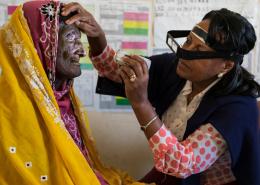Viral vs Bacterial Infections: Different Pathogens, Different Approaches

When you experience symptoms of an infection such as fever, fatigue, decreased appetite, or pain, knowing whether a virus or bacteria is making you sick may be the key to getting the right treatment and feeling better.1,2
Viruses and bacteria are among the most well-known causes of infection.3 Infections occur when viruses or bacteria invade the human host and proliferate.3 But there are some important distinctions between them, and it’s important to determine whether it’s a bacteria or virus causing the illness.1,4
“Bacteria and viruses are quite different microorganisms,” says Oxana Selivanova, a senior director in anti-infectives research, at Pfizer. “Doctors need to diagnose whether a patient has a viral or a bacterial infection because they require different treatments.”
What is a virus?
Viruses are pieces of genetic material (DNA or RNA) contained in protein cases.5 A virus can’t reproduce on its own; it invades and uses the host cell to make new virus copies so that the virus can spread to other cells.5 COVID-19, influenza, smallpox, measles, and the common cold are all examples of viral diseases in humans.5 In addition to infecting humans, viruses can also infect fungi, bacteria, and other species.5
What are bacteria?
Bacteria are small, single-celled organisms that include pathogenic (bad) bacteria and good bacteria.6 Bacteria live in the gut, on mucous membranes and skin, and the human body has 10 times more bacterial cells than human cells.7 Most bacteria are harmless, but some can cause disease, including strep throat, tuberculosis, and staph skin infections.7
Understanding the similarities
Even though we can’t see them, the world is full of bacteria and viruses.1 Infections occur when the microbes enter our bodies and begin multiplying, killing cells or disrupting cell function, leading to illness.7 General symptoms like fever, fatigue, decreased appetite, and pain are common in both viral and bacterial infections.8 Bacteria and viruses are most commonly associated with illness, but the microbes can also be beneficial.1
“We do have beneficial bacteria that help to keep us healthy,” says Ognjen Sekulovic, principal scientist, bacterial vaccines, at Pfizer. “Similar to bacteria, most viruses are harmless to humans. In fact, some of the viruses that infect bacteria are beneficial for controlling the bacterial populations in our GI track and in the environment.”
Different pathogens, different treatments
Despite causing some of the same symptoms, bacteria and viruses require very distinct treatments: Antivirals treat viruses, and antibacterials treat bacteria.1,8
“The public has this perception that a single antibiotic can treat both bacteria and viruses, and that’s not the case,” Sekulovic says. “Antibacterials are effective only against bacteria, not against viruses.”
Testing is needed to determine which microbe is causing illness so the right treatment can be prescribed.1
In the case of a bacterial infection, Selivanova explains that broad-spectrum antibiotics can attack multiple different pathogens while narrow-spectrum antibiotics target fewer, specific bacteria. Identifying the illness-causing bacteria can help guide treatment. Using the wrong treatment — like an antibacterial to treat a virus — isn’t just ineffective; it can be dangerous. Bacteria and viruses can stop responding to the antibiotic medications used to combat them. This is called antimicrobial resistance.9
“In the best-case scenario, using the wrong treatment approach would result in no improvement of illness or delayed recovery, but in the worst-case scenario, it can mean the worsening of symptoms and potentially lead to life-threatening situations, including allergic reactions, drug interactions or other negative outcomes,” says Sekulovic.
Antimicrobial resistance is one of the biggest challenges in treating bacteria and viruses and has been called “one of the top global public health and development threats,” contributing to 4.95 million deaths worldwide in 2019 alone.9
Advances in illness prevention
The diversity of bacteria and viruses and their continuing evolution make antibiotic and antiviral research a critical area of research and forces scientists to continue innovating.
“Both bacteria and viruses have evolved over long periods of time,” Sekulovic says. “We're in a war against a very sophisticated enemy, and now we're trying to outsmart it with new treatments and vaccines. When we succeed, it’s a very rewarding experience and saves lives.”
Vaccines imitate infections, introducing a disease-causing organism to trigger an immune response that identifies and kills foreign substances.10
Sekulovic notes that scientists are making headway in the battle to outsmart viruses and bacteria and points to maternal immunizations, which involves vaccinating a pregnant woman to help transfer antibodies to the unborn child and protect the baby during the most vulnerable first few months of life before their immune system is fully developed – an exciting innovation. Pfizer is developing potential maternal immunizations for Group B streptococcus (GBS) that are one of the leading causes of infant morbidity and mortality worldwide but have limited treatment and preventative approaches.11
Using mRNA technology to develop combination vaccines that target multiple viruses at the same time is another area of research that holds promise, Sekulovic adds. He explains that simplifying the vaccine schedule to target multiple viruses such as influenza and COVID-19 could help improve access in underserved areas.
“Microbes will keep evolving, so anything we do will be innovative because we need to overcome new microbial strains that are resistant to current medications and come up with new solutions,” Selivanova says. “And as pathogens continue to evolve, we’re working to come up with novel drugs. So, there's always going to be work to do, and it's always going to be innovative and exciting.”





